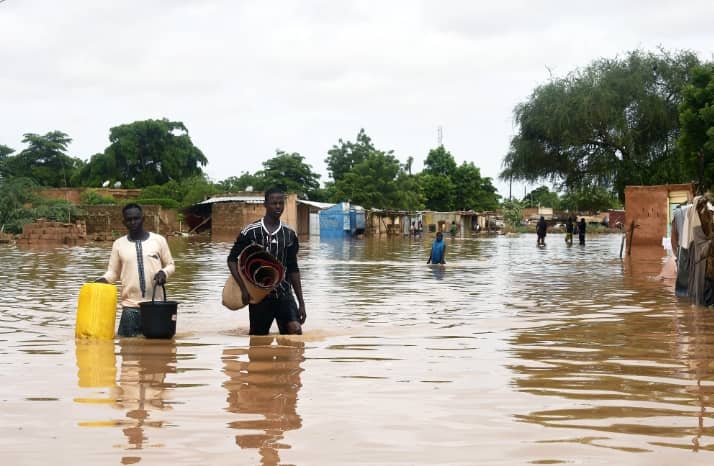By Sakariyah, Ridwanullah
The sun, usually a friend, is now a brutal enemy in Nigeria’s Sahel region. It’s November 2025, and instead of the usual golden sea of millet, fields stretch out like cracked, brittle skin. Families who have tilled this land for generations now face a dire choice: the choice to stay and starve, or to leave. Just a 1°C rise in temperature across this region, according to a recent World Food Programme (WFP) analysis, has pushed an additional 70 million people into severe food insecurity. This reality forces desperate communities, who are currently facing drought and banditry, to abandon farming and migrate towards urban centres like Kano.
This tragedy is not a one-community experience; it is an unfolding crisis that has become order of the day across West Africa. Climate change has become a threat – a daily reality that steals harvests, fuels conflicts, and forces millions to abandon their homes.
READ ALSO: African Union refutes Trump’s genocide claim in Northern Nigeria
Climate Change Poses Threat against Food
Across West Africa, the situation seems to be escalating rapidly. Extreme weather resulting in longer droughts, sudden monster floods, and scorching heatwaves, is relentlessly hammering farms. The Global Report on Food Crises (GRFC) 2025 paints a grim picture of this by showing how these intense climate extremes are crushing harvests and removing the primary source of food for millions. In November 2025, the Food and Agriculture Organization (FAO) held its 17th Multidisciplinary Team Meeting in Abidjan. Their data delivered a chilling warning: over 34 million people in West Africa are now struggling because of climate shocks that continuously compound existing problems. The region is teetering on the edge of a major humanitarian crisis.
Moving on, the struggle to cope is widespread. A November 2025 paper from Afrobarometer on Africans’ adaptation efforts reveals that a shocking 60% of people surveyed reported significant crop losses due to these extreme weather events. Also, independent analysis of satellite imagery reveals the stark geographical truth. Recent data shows vast areas of Senegal completely submerged by unexpected floods, turning farmlands into lakes.
Simultaneously, in Niger, satellite data points to unusually severe and prolonged heatwaves that have baked vast stretches of agricultural land, thereby making cultivation impossible. These incidents aren’t just happening in a particular area; they are part of a dangerous pattern confirmed by the WFP’s Hunger Hotspots report which highlights 16 deepening hotspots across the region where the risk of famine is accelerating.
Fighting for Survival: Climate, Conflict, and Despair
Conflict acts as a disastrous multiplier to the climate crisis. In November 2025, the UN Security Council forecast that conflict is directly intensifying food insecurity across West Africa. In Nigeria, years of displacement caused by groups like Boko Haram have forced millions from their homes in the northeast into crowded IDP camps. This has inevitably halted farming activities and created dependency.
This displacement is compounded by environmental pressures. A 2025 ScienceDirect meta-analysis reveals that in coastal regions, rising sea levels are causing salinity (salt contamination) that renders traditional farmlands useless. Inland, relentless drought in regions spanning Mali and Burkina Faso pushes desperate communities to fight over increasingly scarce water and grazing lands. This interaction between climate and conflict creates a devastating feedback loop: climate change shrinks resources, resource scarcity fuels conflict, and conflict spreads hunger.
The consequences, therefore, are gendered. WFP analysts state that the 1°C temperature rise disproportionately impacts women farmers, who traditionally shoulder the primary responsibility for family food production. When harvests fail, they bear the overwhelming burden of finding alternatives.
Policy Failures and Fading Hope
Amidst this tragedy, a question strikes: why isn’t the political and aid response matching the scale of the disaster?
Data from the region indicates a pervasive struggle to get aid to those who need it most. In Nigeria, despite a staggering 34% inflation rate that makes food unaffordable, reports of underreported corruption in aid distribution persist. This diversion of essential food supplies prevents aid from reaching the most vulnerable communities, magnifying the impact of the climate-induced shortages.
Furthermore, the Economic Community of West African States (ECOWAS), the body meant to lead regional solutions, has seen crucial climate adaptation funds stall. This administrative inertia is delaying crucial resilience projects that could help farmers adapt to new weather patterns.
An FAO West Africa official, speaking after the Abidjan meeting, pointed to systemic policy failures. While the plans for climate adaptation and food security are often scientifically sound, their implementation is often blocked by political and resource constraints.
Glimmers of Resilience
Despite the widespread challenges, resilience stories offer a template for survival. In Ghana, some communities are actively embracing agroforestry, planting trees among their crops. This practice helps to improve soil quality, provide shade, and diversify income sources, successfully defying regional drought trends. These community-led initiatives underscore the potential of indigenous coping mechanisms, though such mechanisms are struggling against the speed of urbanization and the extreme nature of the climate shocks.
READ ALSO: Dead end of African democracy
To this end, the tragedy unfolding across West Africa is very glaring: the accelerating climate crisis is no longer just an environmental threat; it has now become the primary driver of food insecurity and conflict. The data shows that systemic policy failures, stalled regional funds, and chronic corruption are blocking solutions. On this account, the crisis is not only one of weather but one of commitment. The ability of millions to survive depends on the urgent, effective implementation of adaptation measures and a decisive shift from political rhetoric to transparent, localized action that truly supports the region’s most vulnerable farmers.



